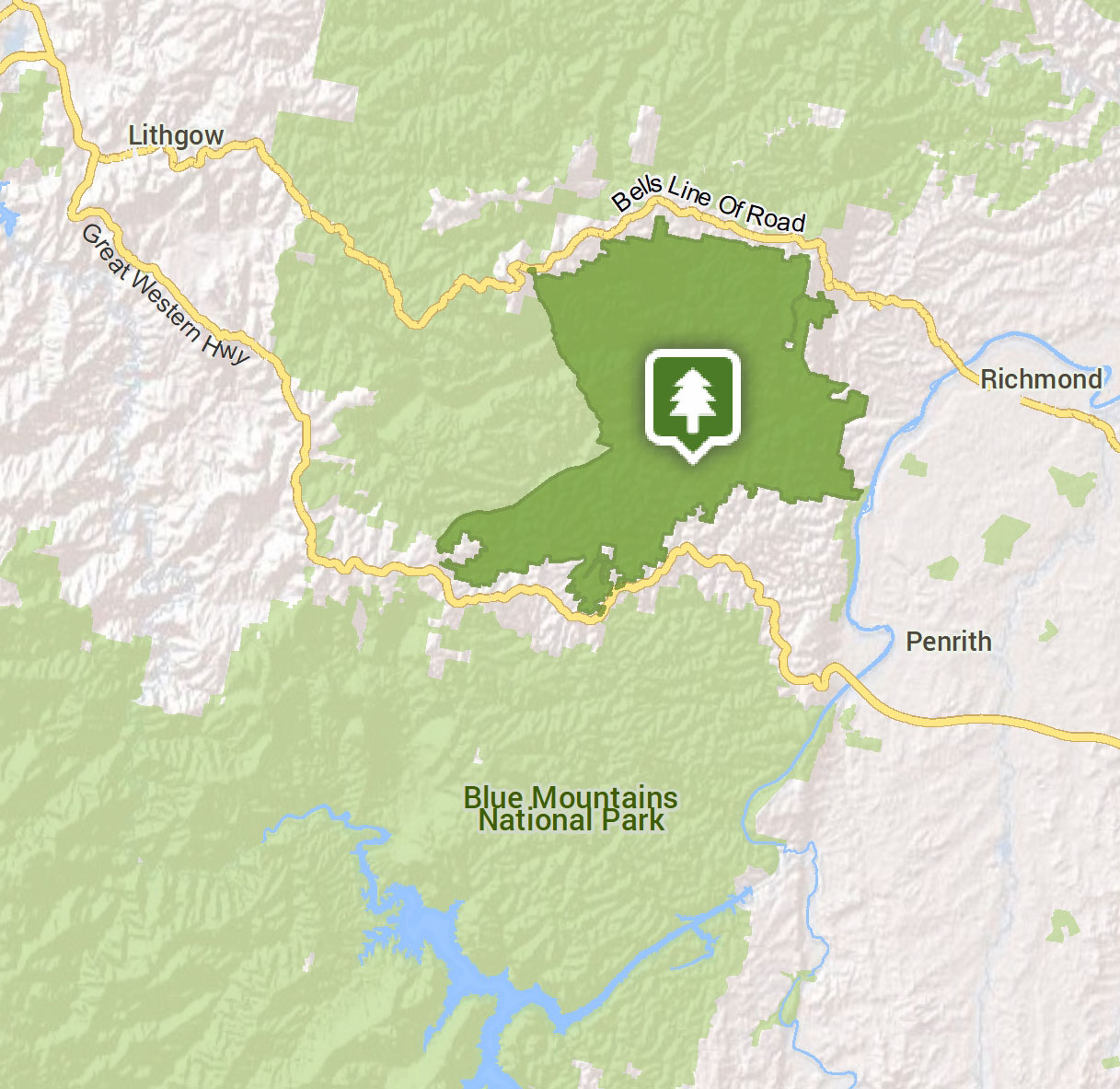Visitor info
All the practical information you need to know about the Lower Grose Valley area.
Getting there and parking
To get to the Lower Grose Valley area of Blue Mountains National Park:
From Sydney:
- Take the M2 and Windsor Road to Richmond, then Bells Line of Road.
- Or head west on the M4 and Great Western Highway towards Lithgow.
- The Great Western Highway and Bells Line of Road are connected between Springwood and Richmond via Hawkesbury, Springwood and Castlereagh Roads.
From Lithgow:
- Follow the Great Western Highway east toward Sydney
- Or follow Chifley Road from Lithgow which becomes the Bells Line of Road.
Parking
- Vale of Avoca lookout See on map
Road quality
- Mixture of sealed and unsealed roads
Parking
- Parking is limited at trail heads.
By bike
- Visit Transport for NSW for cycling and bike transport information.
By public transport
- Regular daily trains run from Sydney Central Station to Faulconbridge and Woodford. The trip takes around 1.5hrs. Visit Transport for NSW to plan your trip.
- You’ll need to walk or ride between 2.5km and 5.5km to the national park tracks and trails.
Best times to visit
The Lower Grose Valley area is a great place to visit at any time of year. Here are some of the highlights.
Autumn
Dry weather and clear skies make this a great time to pack up the 4WD and enjoy a night by the campfire at Burralow Creek campground. After a day exploring, gaze up at the starry skies and try to spot the nocturnal wildlife. During the day, keep an eye out for spotted quail-thrush at Blue Gum Swamp, near Winmalee. You may see male lyrebirds put on a vocal display to attract females.
Spring
From late September, iconic red waratahs bloom in the lower Blue Mountains, making this the perfect time to 4WD to Burralow Creek or visit Bowen Mountain. Springtime is a feast for the senses along Faulconbridge Ridge trail, which is lined with yellow pea flowers, pink boronias, and the creamy flowers of bloodwood and tea tree. Add a few birds to your twitch list at Blue Gum Swamp, such as the red-browed treecreeper or scarlet honeyeater. Why not try your luck fishing for bass in the lower Grose River between spring and early summer (licence required).
Summer
On a hot summer’s day, escape to the dappled shade of Blue Gum Swamp or the cool rainforest gullies along Transit of Venus walk. After summer rain, the trickling waterfalls turn to flowing cascades with refreshing sprays over the rock overhangs. If water levels are high (and safe), it’s possible to kayak from the Hawkesbury River around 5km upstream along the Grose River. You can also walk down the steep, unmarked track from Vale of Avoca lookout to reach the Grose River, where you can go liloing.
Winter
Breathe in the fresh mountain air and soak in the solitude on a winter walk. Breeze along mountain bike ride along trails lined with yellow wattle. Afterwards, warm up at one of the nearby mountain village cafes. Winter-flowering heath banksia and hair-pin banksia are important food sources for animals and birds when little else is flowering.
Facilities
Maps and downloads
Permitted
Camp fires and solid fuel burners
Permitted in designated fireplaces only.
Fishing
A current NSW recreational fishing licence is required when fishing in all waters.
Horses
Horses are permitted on Tabaraga Ridge fire trail and Paterson Range fire trail. Horse riders should be aware that these are popular 4WD and motorbike touring trails. Contact the Richmond office for alternative horse riding experiences in the Hawkesbury area.
Prohibited
Gathering firewood
Pets
Pets and domestic animals (other than certified assistance animals) are not permitted. Find out which regional parks allow dog walking and see the pets in parks policy for more information.
Smoking
NSW national parks are no smoking areas.

Contact
- in Blue Mountains National Park in the Sydney and surrounds region
Lower Grose Valley area is always open but may have to close at times due to poor weather or fire danger.
-
-
Hawkesbury-Nattai office
02 4720 6200
Contact hours: 9am to 4pm Monday to Friday. Glenbrook entry station is only open on weekends, public holidays and school holidays. - 68 Bruce Road, Glenbrook NSW 2773
-
Email: npws.hawkesburynattai@environment.nsw.gov.au
-
Hawkesbury-Nattai office
Nearby towns
Springwood (6 km)
The Sassafras Gully Loop is one of a number of excellent walks in Springwood. The trail takes you from Springwood Station and past wonderful rock features, dense bushland and waterfalls. It's a nice cool walk in the shade and you're never too far from water.
Katoomba (20 km)
Katoomba is at the heart of most of the stunning natural attractions that make up the Blue Mountains National Park. You can admire deep valleys, sandstone plateaus, waterfalls and native animals from the many walking trails and lookouts near Katoomba.
Windsor (20 km)
Explore Windsor's historic buildings, including St Matthew's Anglican Church (1817), Windsor Court House (1822), and the Macquarie Arms Hotel (1815). Bring a picnic or your boat and enjoy the beautiful riverside parks in Windsor including Howe Park and Governor Phillip Park.
